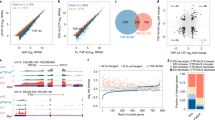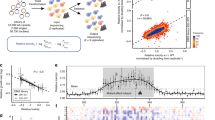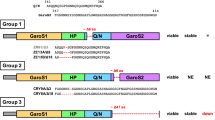Abstract
Amyotrophic lateral sclerosis (ALS) is a devastating neurodegenerative disease primarily affecting motor neurons. Mutations in the gene encoding TDP-43 cause some forms of the disease, and cytoplasmic TDP-43 aggregates accumulate in degenerating neurons of most individuals with ALS. Thus, strategies aimed at targeting the toxicity of cytoplasmic TDP-43 aggregates may be effective. Here, we report results from two genome-wide loss-of-function TDP-43 toxicity suppressor screens in yeast. The strongest suppressor of TDP-43 toxicity was deletion of DBR1, which encodes an RNA lariat debranching enzyme. We show that, in the absence of Dbr1 enzymatic activity, intronic lariats accumulate in the cytoplasm and likely act as decoys to sequester TDP-43, preventing it from interfering with essential cellular RNAs and RNA-binding proteins. Knockdown of Dbr1 in a human neuronal cell line or in primary rat neurons is also sufficient to rescue TDP-43 toxicity. Our findings provide insight into TDP-43–mediated cytotoxicity and suggest that decreasing Dbr1 activity could be a potential therapeutic approach for ALS.
This is a preview of subscription content, access via your institution
Access options
Subscribe to this journal
Receive 12 print issues and online access
$209.00 per year
only $17.42 per issue
Buy this article
- Purchase on Springer Link
- Instant access to full article PDF
Prices may be subject to local taxes which are calculated during checkout





Similar content being viewed by others
References
Boillée, S., Vande Velde, C. & Cleveland, D.W. ALS: a disease of motor neurons and their nonneuronal neighbors. Neuron 52, 39–59 (2006).
Rosen, D.R. et al. Mutations in Cu/Zn superoxide dismutase gene are associated with familial amyotrophic lateral sclerosis. Nature 362, 59–62 (1993).
Bruijn, L.I. et al. Aggregation and motor neuron toxicity of an ALS-linked SOD1 mutant independent from wild-type SOD1. Science 281, 1851–1854 (1998).
Smith, R.A. et al. Antisense oligonucleotide therapy for neurodegenerative disease. J. Clin. Invest. 116, 2290–2296 (2006).
Lagier-Tourenne, C., Polymenidou, M. & Cleveland, D.W. TDP-43 and FUS/TLS: emerging roles in RNA processing and neurodegeneration. Hum. Mol. Genet. 19, R46–R64 (2010).
Gitler, A.D. & Shorter, J. RNA-binding proteins with prion-like domains in ALS and FTLD-U. Prion 5, 179–187 (2011).
Mackenzie, I.R. et al. Pathological TDP-43 distinguishes sporadic amyotrophic lateral sclerosis from amyotrophic lateral sclerosis with SOD1 mutations. Ann. Neurol. 61, 427–434 (2007).
Neumann, M. et al. Ubiquitinated TDP-43 in frontotemporal lobar degeneration and amyotrophic lateral sclerosis. Science 314, 130–133 (2006).
Pesiridis, G.S., Lee, V.M. & Trojanowski, J.Q. Mutations in TDP-43 link glycine-rich domain functions to amyotrophic lateral sclerosis. Hum. Mol. Genet. 18, R156–R162 (2009).
Rutherford, N.J. et al. Novel mutations in TARDBP (TDP-43) in patients with familial amyotrophic lateral sclerosis. PLoS Genet. 4, e1000193 (2008).
Sreedharan, J. et al. TDP-43 mutations in familial and sporadic amyotrophic lateral sclerosis. Science 319, 1668–1672 (2008).
Van Deerlin, V.M. et al. TARDBP mutations in amyotrophic lateral sclerosis with TDP-43 neuropathology: a genetic and histopathological analysis. Lancet Neurol. 7, 409–416 (2008).
Yokoseki, A. et al. TDP-43 mutation in familial amyotrophic lateral sclerosis. Ann. Neurol. 63, 538–542 (2008).
Belzil, V.V. et al. Mutations in FUS cause FALS and SALS in French and French Canadian populations. Neurology 73, 1176–1179 (2009).
Corrado, L. et al. Mutations of FUS gene in sporadic amyotrophic lateral sclerosis. J. Med. Genet. 47, 190–194 (2010).
Hewitt, C. et al. Novel FUS/TLS mutations and pathology in familial and sporadic amyotrophic lateral sclerosis. Arch. Neurol. 67, 455–461 (2010).
Kwiatkowski, T.J. Jr. et al. Mutations in the FUS/TLS gene on chromosome 16 cause familial amyotrophic lateral sclerosis. Science 323, 1205–1208 (2009).
Vance, C. et al. Mutations in FUS, an RNA processing protein, cause familial amyotrophic lateral sclerosis type 6. Science 323, 1208–1211 (2009).
Johnson, B.S., McCaffery, J.M., Lindquist, S. & Gitler, A.D. A yeast TDP-43 proteinopathy model: exploring the molecular determinants of TDP-43 aggregation and cellular toxicity. Proc. Natl. Acad. Sci. USA 105, 6439–6444 (2008).
Johnson, B.S. et al. TDP-43 is intrinsically aggregation-prone, and amyotrophic lateral sclerosis–linked mutations accelerate aggregation and increase toxicity. J. Biol. Chem. 284, 20329–20339 (2009).
Sun, Z. et al. Molecular determinants and genetic modifiers of aggregation and toxicity for the ALS disease protein FUS/TLS. PLoS Biol. 9, e1000614 (2011).
Elden, A.C. et al. Ataxin-2 intermediate-length polyglutamine expansions are associated with increased risk for ALS. Nature 466, 1069–1075 (2010).
Lagier-Tourenne, C. & Cleveland, D.W. Neurodegeneration: an expansion in ALS genetics. Nature 466, 1052–1053 (2010).
Willingham, S., Outeiro, T.F., DeVit, M.J., Lindquist, S.L. & Muchowski, P.J. Yeast genes that enhance the toxicity of a mutant huntingtin fragment or α-synuclein. Science 302, 1769–1772 (2003).
Giorgini, F., Guidetti, P., Nguyen, Q., Bennett, S.C. & Muchowski, P.J. A genomic screen in yeast implicates kynurenine 3-monooxygenase as a therapeutic target for Huntington disease. Nat. Genet. 37, 526–531 (2005).
Tong, A.H. et al. Systematic genetic analysis with ordered arrays of yeast deletion mutants. Science 294, 2364–2368 (2001).
Schuldiner, M. et al. Exploration of the function and organization of the yeast early secretory pathway through an epistatic miniarray profile. Cell 123, 507–519 (2005).
Barmada, S.J. et al. Cytoplasmic mislocalization of TDP-43 is toxic to neurons and enhanced by a mutation associated with familial amyotrophic lateral sclerosis. J. Neurosci. 30, 639–649 (2010).
Arrasate, M., Mitra, S., Schweitzer, E.S., Segal, M.R. & Finkbeiner, S. Inclusion body formation reduces levels of mutant huntingtin and the risk of neuronal death. Nature 431, 805–810 (2004).
Arenas, J. & Hurwitz, J. Purification of a RNA debranching activity from HeLa cells. J. Biol. Chem. 262, 4274–4279 (1987).
Chapman, K.B. & Boeke, J.D. Isolation and characterization of the gene encoding yeast debranching enzyme. Cell 65, 483–492 (1991).
Domdey, H. et al. Lariat structures are in vivo intermediates in yeast pre-mRNA splicing. Cell 39, 611–621 (1984).
Khalid, M.F., Damha, M.J., Shuman, S. & Schwer, B. Structure-function analysis of yeast RNA debranching enzyme (Dbr1), a manganese-dependent phosphodiesterase. Nucleic Acids Res. 33, 6349–6360 (2005).
Franks, T.M., Singh, G. & Lykke-Andersen, J. Upf1 ATPase-dependent mRNP disassembly is required for completion of nonsense-mediated mRNA decay. Cell 143, 938–950 (2010).
Gatfield, D. & Izaurralde, E. Nonsense-mediated messenger RNA decay is initiated by endonucleolytic cleavage in Drosophila. Nature 429, 575–578 (2004).
Lejeune, F., Li, X. & Maquat, L.E. Nonsense-mediated mRNA decay in mammalian cells involves decapping, deadenylating, and exonucleolytic activities. Mol. Cell 12, 675–687 (2003).
Larimer, F.W., Hsu, C.L., Maupin, M.K. & Stevens, A. Characterization of the XRN1 gene encoding a 5′→3′ exoribonuclease: sequence data and analysis of disparate protein and mRNA levels of gene-disrupted yeast cells. Gene 120, 51–57 (1992).
van Dijk, E.L. et al. XUTs are a class of Xrn1-sensitive antisense regulatory non-coding RNA in yeast. Nature 475, 114–117 (2011).
Igaz, L.M. et al. Dysregulation of the ALS-associated gene TDP-43 leads to neuronal death and degeneration in mice. J. Clin. Invest. 121, 726–738 (2011).
Zhang, Y.J. et al. Aberrant cleavage of TDP-43 enhances aggregation and cellular toxicity. Proc. Natl. Acad. Sci. USA 106, 7607–7612 (2009).
Winton, M.J. et al. Disturbance of nuclear and cytoplasmic TAR DNA-binding protein (TDP-43) induces disease-like redistribution, sequestration, and aggregate formation. J. Biol. Chem. 283, 13302–13309 (2008).
Haim, L., Zipor, G., Aronov, S. & Gerst, J.E. A genomic integration method to visualize localization of endogenous mRNAs in living yeast. Nat. Methods 4, 409–412 (2007).
Haim-Vilmovsky, L. & Gerst, J.E. m-TAG: a PCR-based genomic integration method to visualize the localization of specific endogenous mRNAs in vivo in yeast. Nat. Protoc. 4, 1274–1284 (2009).
Haim-Vilmovsky, L. & Gerst, J.E. Visualizing endogenous mRNAs in living yeast using m-TAG, a PCR-based RNA aptamer integration method, and fluorescence microscopy. Methods Mol. Biol. 714, 237–247 (2011).
Mayas, R.M., Maita, H., Semlow, D.R. & Staley, J.P. Spliceosome discards intermediates via the DEAH box ATPase Prp43p. Proc. Natl. Acad. Sci. USA 107, 10020–10025 (2010).
Buratti, E. & Baralle, F.E. Characterization and functional implications of the RNA binding properties of nuclear factor TDP-43, a novel splicing regulator of CFTR exon 9. J. Biol. Chem. 276, 36337–36343 (2001).
Polymenidou, M. et al. Long pre-mRNA depletion and RNA missplicing contribute to neuronal vulnerability from loss of TDP-43. Nat. Neurosci. 14, 459–468 (2011).
Suzuki, H. et al. Characterization of RNase R–digested cellular RNA source that consists of lariat and circular RNAs from pre-mRNA splicing. Nucleic Acids Res. 34, e63 (2006).
Voigt, A. et al. TDP-43–mediated neuron loss in vivo requires RNA-binding activity. PLoS ONE 5, e12247 (2010).
Li, Y. et al. A Drosophila model for TDP-43 proteinopathy. Proc. Natl. Acad. Sci. USA 107, 3169–3174 (2010).
Yang, C. et al. The C-terminal TDP-43 fragments have a high aggregation propensity and harm neurons by a dominant-negative mechanism. PLoS ONE 5, e15878 (2010).
Estes, P.S. et al. Wild-type and A315T mutant TDP-43 exert differential neurotoxicity in a Drosophila model of ALS. Hum. Mol. Genet. 20, 2308–2321 (2011).
Sephton, C.F. et al. Identification of neuronal RNA targets of TDP-43–containing ribonucleoprotein complexes. J. Biol. Chem. 286, 1204–1215 (2011).
Tollervey, J.R. et al. Characterizing the RNA targets and position-dependent splicing regulation by TDP-43. Nat. Neurosci. 14, 452–458 (2011).
Xiao, S. et al. RNA targets of TDP-43 identified by UV-CLIP are deregulated in ALS. Mol. Cell Neurosci. 47, 167–180 (2011).
Ye, Y., De Leon, J., Yokoyama, N., Naidu, Y. & Camerini, D. DBR1 siRNA inhibition of HIV-1 replication. Retrovirology 2, 63 (2005).
Xia, H., Mao, Q., Paulson, H.L. & Davidson, B.L. siRNA-mediated gene silencing in vitro and in vivo. Nat. Biotechnol. 20, 1006–1010 (2002).
Xia, H. et al. RNAi suppresses polyglutamine-induced neurodegeneration in a model of spinocerebellar ataxia. Nat. Med. 10, 816–820 (2004).
Singer, O. et al. Targeting BACE1 with siRNAs ameliorates Alzheimer disease neuropathology in a transgenic model. Nat. Neurosci. 8, 1343–1349 (2005).
Kordasiewicz, H.B. et al. Sustained therapeutic reversal of Huntington′s disease by transient repression of Huntingtin synthesis. Neuron 74, 1031–1044 (2012).
Da Cruz, S. & Cleveland, D.W. Understanding the role of TDP-43 and FUS/TLS in ALS and beyond. Curr. Opin. Neurobiol. 21, 904–919 (2011).
Cooper, A.A. et al. Alpha-synuclein blocks ER-Golgi traffic and Rab1 rescues neuron loss in Parkinson′s models. Science 313, 324–328 (2006).
Duennwald, M.L. & Lindquist, S. Impaired ERAD and ER stress are early and specific events in polyglutamine toxicity. Genes Dev. 22, 3308–3319 (2008).
Tong, A.H. et al. Global mapping of the yeast genetic interaction network. Science 303, 808–813 (2004).
Tong, A.H. & Boone, C. Synthetic genetic array analysis in Saccharomyces cerevisiae. Methods Mol. Biol. 313, 171–192 (2006).
Armakola, M., Hart, M.P. & Gitler, A.D. TDP-43 toxicity in yeast. Methods 53, 238–245 (2011).
Collins, S.R., Schuldiner, M., Krogan, N.J. & Weissman, J.S. A strategy for extracting and analyzing large-scale quantitative epistatic interaction data. Genome Biol. 7, R63 (2006).
Sharma, P., Ando, D.M., Daub, A., Kaye, J.A. & Finkbeiner, S. High-throughput screening in primary neurons. Methods Enzymol. 506, 331–360 (2012).
Arrasate, M. & Finkbeiner, S. Automated microscope system for determining factors that predict neuronal fate. Proc. Natl. Acad. Sci. USA 102, 3840–3845 (2005).
Shinbo, Y. et al. Proper SUMO-1 conjugation is essential to DJ-1 to exert its full activities. Cell Death Differ. 13, 96–108 (2006).
Rothrock, C.R., House, A.E. & Lynch, K.W. HnRNP L represses exon splicing via a regulated exonic splicing silencer. EMBO J. 24, 2792–2802 (2005).
Acknowledgements
We thank K. Lynch and S. Smith for helpful suggestions and discussions about RNA and splicing; T. Nakaya for advice and assistance with lentivirus transduction experiments and analysis; C. Kurischko for advice and assistance with visualizing P bodies and stress granules; Q. Mitrovich and A. Plocik for advice with running the two-dimensional nucleic acid gels; S. Collins and D. Cameron for useful advice and assistance in performing the data analysis for screen 2; B. Hodges, D. Hosangadi, P. Patel, P. Nathanson and C. Mrejen for assistance with yeast experiments; J. Epstein and A. Raphael for critical comments on the manuscript and helpful suggestions; and G. Howard for editorial assistance. A. Elden helped with initial stages of this project. We are grateful to J. Gerst (Weizmann Institute) for providing the yeast m-TAG plasmids, R. Parker (University of Arizona) for sharing the P-body and stress granule marker plasmids and J. Weibezahn (University of California, San Francisco) for providing temperature-sensitive CDC48 (cdc48-3, SM 4783) and wild-type CDC48 isogenic (SM 5124) yeast strains. We thank B. Schwer (Weill Cornell Medical College) for providing the yeast mutant Dbr1 expression plasmids. We thank C. Boone (University of Toronto) for the MATα strain Y7092. This work was supported by US National Institutes of Health (NIH) Director's New Innovator Awards 1DP2OD004417 (to A.D.G.) and 1DP2OD002177 (to J.S.), NIH grants NS065317 and NS065317 (to A.D.G.), NS067354 (to J.S.), GM084448, GM084279, GM081879 and GM098101 (to N.J.K.), NS39074 and NS045491 (to S.F.) and NS072233 (to S.J.B.), a New Scholar in Aging Award from the Ellison Medical Foundation (to J.S.), a grant from the Packard Center for ALS Research at Johns Hopkins (A.D.G. and J.S.), a grant from the Consortium for Frontotemporal Research (to R.V.F.), NIH grant 2P01AG02074 (to S.F.), a grant from the ALS Association (to S.F.) and the Taube-Koret Center and Hellman Family Foundation (to S.F.). A.D.G. is a Pew Scholar in the Biomedical Sciences, supported by The Pew Charitable Trusts, and a Rita Allen Foundation Scholar. N.J.K. is a Searle Scholar and a Keck Young Investigator. R.V.F. is an Investigator of the Gladstone Institutes. The J. David Gladstone Institutes received support from National Center for Research Resources Grant RR18928.
Author information
Authors and Affiliations
Contributions
M.A., M.J.H., M.D.F., S.J.B., J.S., N.J.K., S.F., R.V.F. and A.D.G. designed the experiments. M.A., M.J.H., M.D.F., S.J.B., J.S., E.A.S., Z.D., X.F. and A.D.G. performed the research. M.A., M.J.H., M.D.F., S.J.B., J.S., N.J.K., S.F., R.V.F. and A.D.G. analyzed and interpreted data. M.A., M.J.H., M.D.F., S.J.B., S.F., R.V.F. and A.D.G. wrote the manuscript with contributions from all authors.
Corresponding authors
Ethics declarations
Competing interests
A.D.G. is an inventor on patents and patent applications that have been licensed to FoldRx.
Supplementary information
Supplementary Text and Figures
Supplementary Figures 1–6, Supplementary Table 1 and Supplementary Note (PDF 7108 kb)
Supplementary Data
Results of TDP-43 toxicity modifier screen (supplied as separate Excel file) (XLSX 542 kb)
Rights and permissions
About this article
Cite this article
Armakola, M., Higgins, M., Figley, M. et al. Inhibition of RNA lariat debranching enzyme suppresses TDP-43 toxicity in ALS disease models. Nat Genet 44, 1302–1309 (2012). https://doi.org/10.1038/ng.2434
Received:
Accepted:
Published:
Issue Date:
DOI: https://doi.org/10.1038/ng.2434
This article is cited by
-
Biological role and regulation of circular RNA as an emerging biomarker and potential therapeutic target for cancer
Molecular Biology Reports (2024)
-
A novel intronic circular RNA circFGFR1int2 up-regulates FGFR1 by recruiting transcriptional activators P65/FUS and suppressing miR-4687-5p to promote prostate cancer progression
Journal of Translational Medicine (2023)
-
Mitigating a TDP-43 proteinopathy by targeting ataxin-2 using RNA-targeting CRISPR effector proteins
Nature Communications (2023)
-
CircPAK1 promotes the progression of hepatocellular carcinoma via modulation of YAP nucleus localization by interacting with 14-3-3ζ
Journal of Experimental & Clinical Cancer Research (2022)
-
Insights into the multifaceted role of circular RNAs: implications for Parkinson’s disease pathogenesis and diagnosis
npj Parkinson's Disease (2022)



